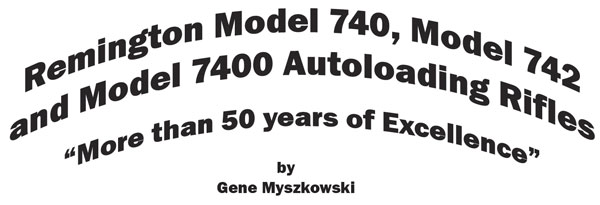
Remington Model 740A Autoloading Rifle
Introduced in 1955, over 2.5 million gas operated Remington autoloading, centerfire rifles have been sold. The original 1955 Model 740 and the current Model 7400 are favorites of deer hunters and carry on a proud tradition of fine autoloading, centerfire rifles from Remington that began in 1906. The original John Browning designed autoloader was first called The Remington Autoloading Rifle and was later renamed in Remington’s 1911 catalog to the now familiar Model 8. Its reliability is legendary and many early models are still in use today. Over 69,490 Model 8s, in calibers .25 Remington, .30 Remington, .32 Remington and .35 Remington were made from 1906 to 1936.
A Du Pont executive, Charles Krum Davis, took over as Remington Arms Company President in 1933. He realized that the venerable Model 8 autoloading rifle was outdated and expensive to manufacture. A cosmetic rework, started in 1934, resulted in the June 1936 introduction of the Model 81. It was now called the Woodmaster and at least 55,581, in calibers .25 Remington, .30 Remington, .300 Savage, .32 Remington and .35 Remington were made from 1936 to the end of production in 1950.
Serious work on a completely new autoloading centerfire rifle was started in 1940 and given the engineering studies designation – Model 740. The new Model 740 and its sibling – the Model 760 pump-action rifle – followed parallel development paths until the December 7, 1941 Japanese bombing of Pearl Harbor when all of Remington’s domestic projects were put on hold. Development work resumed in late 1943 and by July 12, 1944 a formal proposal for development, testing and production was requested. A prototype, in caliber .30-06, was later demonstrated in 1944. It utilized an
aluminum alloy receiver large enough to accommodate the .300 H&H Magnum.
By 1947 there were two gun design teams working on both the autoloading and pump action rifles – Remington’s Technical Division, Ilion, New York working on the Models 740 and 760 and the Du Pont Engineering Department in Wilmington, Delaware working on the Models 742 and 762. An inevitable turf war developed and President Davis resolved the conflict November 11, 1947 by making Du Pont’s L. Ray Crittendon, who originally managed the design of the Springfield 1903A3 during World War II and later the Model 11-48 autoloading shotgun, a part of the Remington design team. His Models 742 autoloading rifle and 762 pump action rifle, based on the dimensions of the 28 gauge Model 11-48 shotgun receiver, eventually were selected and subjected to extended function and endurance tests. He also, in 1951, developed the autoloading rifle magazine bolt release that had generated some discussion in the early years. Remington’s safety principle, used since 1906, was to see the rifle empty and open after the last shot is fired. It is still in use today.
In the late 1940s, three gas operating systems, tappet as used in the M1 Carbine, gas expansion as used in the M1 Garand and impulse reaction, were tested using a caliber .30-06 Model 721 bolt action rifle. The gas systems did not operate the bolt but instead were connected to instruments measuring the force generated over time. The impulse reaction system of gas flowing in a tube that impinges on a blind hole in the action bar was selected.
The Model 742 engineering studies designation was changed to the Model 740 Woodmaster on May 22, 1950.
Page 14 4th Quarter 2009

Page 15 4th Quarter 2009
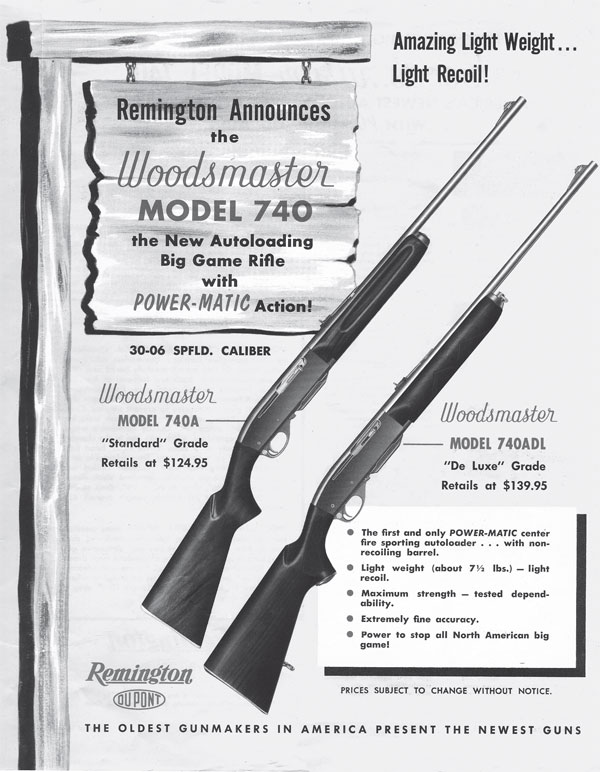
Page 16 4th Quarter 2009
The new Model 740’s introduction, originally scheduled for the same January 1952 date as the new Model 760 pump-action rifle, was delayed three years until February 1, 1955. Problems with the exhaust gas corroding the forearm liner, hard opening of the bolt and magazine feeding problems contributed to the delay.
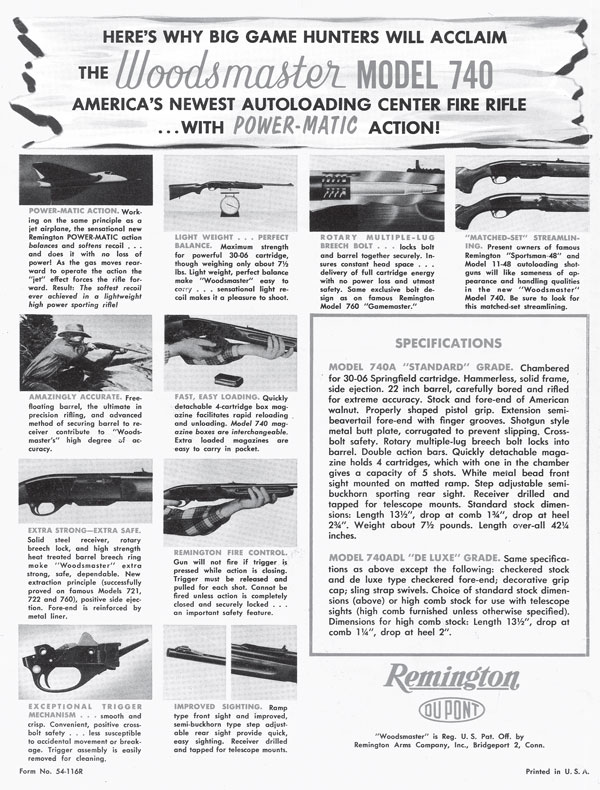 The prices shown are the suggested retail prices in the year of introduction. The new Model 740 was introduced to the public in Remington’s 1955 consumer catalog. The receiver was drilled and tapped for scope mounts and a receiver sight. The new rifle had an overall length of 42 ¼ inches, a barrel of 22 inches, and weighed 7 ½ pounds. It was offered only in caliber .30-06 and in two grades: A – standard at $124.95 and ADL – “A Deluxe” at $139.95. The ADL grade featured a high comb, checkered straight grain walnut stock with grip cap and sling swivels. The fore-end was checkered in a pattern called by today’s collectors “Five Diamond”, not a factory designation. The BDL – “B Deluxe Special” grade, introduced later that year for an additional $20.00, was the same as the ADL except the wood was figured. A few rifles have been observed with the BDL grade engraved after the model number but this is the exception. Sales in 1955 surpassed all marketing expectations and totaled 97,620 rifles of which 74% were A grade.
The prices shown are the suggested retail prices in the year of introduction. The new Model 740 was introduced to the public in Remington’s 1955 consumer catalog. The receiver was drilled and tapped for scope mounts and a receiver sight. The new rifle had an overall length of 42 ¼ inches, a barrel of 22 inches, and weighed 7 ½ pounds. It was offered only in caliber .30-06 and in two grades: A – standard at $124.95 and ADL – “A Deluxe” at $139.95. The ADL grade featured a high comb, checkered straight grain walnut stock with grip cap and sling swivels. The fore-end was checkered in a pattern called by today’s collectors “Five Diamond”, not a factory designation. The BDL – “B Deluxe Special” grade, introduced later that year for an additional $20.00, was the same as the ADL except the wood was figured. A few rifles have been observed with the BDL grade engraved after the model number but this is the exception. Sales in 1955 surpassed all marketing expectations and totaled 97,620 rifles of which 74% were A grade.
The first production Model 740, serial number 1001, “F” grade engraved and inlaid with gold game scenes by Remington master engraver Carl Ennis, was presented to President Davis. It is now on permanent display in the Remington Museum, Ilion, New York.
May 1956 saw the introduction of the caliber .308 Winchester. Total sales that year were 50,143 of which 11,313 were in caliber .308 Winchester. It is interesting to note that in the first two years the Model 740 production totaled 147,763 rifles or 22,692 more than the total combined production of the Models 8 and 81 from 1906 to the end of production in 1950.
The .244 Remington was added to the list of calibers in 1957. The 1958 changes included the addition of the .280 Remington caliber and the discontinuance of the BDL grade. The Model 740 was discontinued December 31, 1959 with a total production of 252,275 including
35 D & F grade engraved rifles. Around 1,000 caliber .244 Remington Model 740s remained in the warehouse and sales, in this caliber, continued through 1961 to clear the inventory.
The Model 742 began as a Model 740 improvement program in the spring of 1958. It addressed the cartridge ejection problem by repositioning the extractor and ejector along with widening the receiver ejection port. A latch was fitted to the bolt preventing bolt rotation when unlocked. The scope of the redesign program was expanded in April 1959 to improve the accuracy of the rifle. A double pitch screw provides the proper fore-end clearance. Changes were also made to the operating handle, gas nozzle and magazine latch. The magazine feed lips were changed to improve cartridge feeding. This improved magazine has the caliber designation boxed.
Page 17 4th Quarter 2009
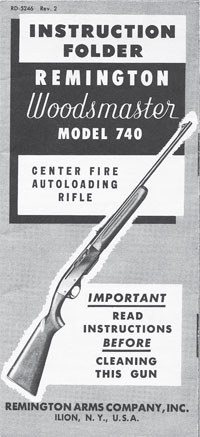
The new Model 742, in two grades and three calibers .30-06, .308 Winchester and .280 Remington, was introduced January 6, 1960. The standard A grade,at $138.50, had a plain uncheckered buttstock and vertical grooves on the forearm. The $154.45 ADL “Deluxe” grade featured checkering on the all purpose buttstock and forearm, grip cap and roll engraved game scenes on both side panels. A screw attached rear sight, step adjustable for elevation and screw adjustable for windage and set on a base was standard for both grades.
The Model 742 carbine, with a 18 ½ inch barrel and 7 ¼ pound weight, was introduced a year later in 1961. 742 CARBINE was stamped in large letters after the caliber designation on the barrel. The CDL carbine grade was equivalent to the ADL grade rifle. The prices were the same as the rifles.
The single Standard grade stock with pressed checkering replaced the A, ADL, C, and CDL grades in 1964 and cost $149.95. The Model 742 BDL Deluxe, later called the Custom Deluxe, was introduced in 1966 for $169.95. It featured a stepped receiver, Monte Carlo buttstock, flat forearm and pressed basketweave checkering. It was available in a left handed version; however, cartridge ejection was still right handed.
The Model 742 serial number sequence was changed on November 26, 1968 as a result of the 1968 Gun Control Act that required no two guns from the same manufacturer have the same serial number. The initial Model 742 serial number sequence began at 1001 and ended at 396562. The new serial number sequence, now shared with the Model 760 pump-action rifle, began at 6900000.
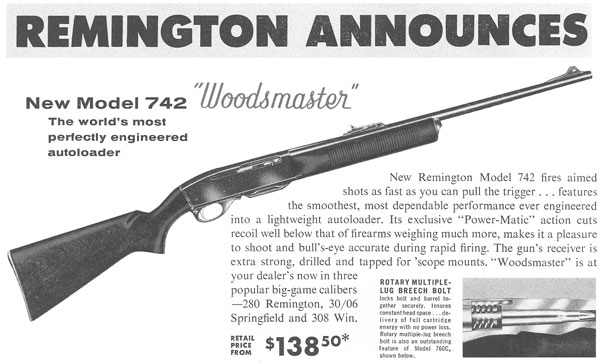 Page 18 4th Quarter 2009 Model 742 Cut-Away Rifle (1st Version) Model 742 Autoloading Rifle (2nd Version) Model 742 Autoloading Rifle (3rd Version) Model 742 Autoloading Carbine (1st Version) Model 742 Autoloading Carbine (2nd Version) Model 742 CDL Autoloading Carbine
Page 18 4th Quarter 2009 Model 742 Cut-Away Rifle (1st Version) Model 742 Autoloading Rifle (2nd Version) Model 742 Autoloading Rifle (3rd Version) Model 742 Autoloading Carbine (1st Version) Model 742 Autoloading Carbine (2nd Version) Model 742 CDL Autoloading Carbine
The Remington Model 742 was discontinued December 31, 1980 with the introduction of the Model Four and Model 7400. However, sales continued well into 1981 to clean out warehouse stock. Only 75 Model 742s were engraved in D and F grades.
The total production of the Model 742 was 1,497,169 of which 113,970 were carbines. A percentage of sales by caliber and years offered include:
- .30-06 – 75%, 1960-1980
- .308 Winchester – 12%, 1960-1980
- .280 Remington – 5%, 1960-1980
- .243 Winchester – 6%, 1968-1980
- 6mm Remington – 2%, 1963-1980
In 1974 Remington began a major product improvement program to replace both the autoloader Model 742 and the pump action Model 760. By 1976 development of the “New Generation Rifles,” as the models were called, was well under way. The new autoloader rifles, now with model numbers, were introduced in late 1980 as the deluxe Model Four and the popular-priced Model 7400. Advertising both in the catalog and the sporting press concentrated on the Model Four, and it wasn’t until 1983 that the Model 7400 received equal billing.
The major improvements over the Model 742 were a simpler bolt, which now had four lugs in place of nineteen, and a single unit replacing the breech ring and barrel extension. A self centering conical gas seal between the barrel lug nozzle and the action bar improved gas sealing and provided more consistent bolt speed. Smoother operation came from a hardened steel receiver insert mated to a matching lug on the bolt and heavier action bars. The magazine was redesigned and the magazine release increased in size. The scope mount screw size and screw hole spacing were increased for greater strength, thus Model 742 scope mounts will not fit. Both the Models Four and 7400 retained the original Model 742 specifications of an overall length of 42 inches, a barrel of 22 inches, and weight of 7 ½ pounds. The Model 7400 cost $399.95 and the Model Four $449.95.
Page 19 4th Quarter 2009
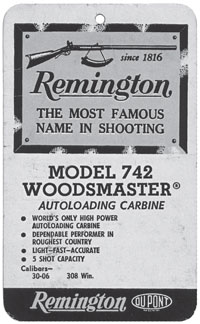
Page 20 4th Quarter 2009
Remington Model Four Autoloading Rifle
The Remington Model Four was introduced January 1981 as a replacement for the Model 742 BDL Custom Deluxe. It featured positive cut checkering on a slimmer pistol grip, full cheekpiece Monte Carlo buttstock, and a flared forearm. A cartridge head medallion denoting the caliber was inlaid in the barrel extension. Serial numbers, shared with the Model Six pump-action rifle, started at A4000000. It was not offered in the 1988 catalog as production ended December 31, 1987. A total of 68,085 rifles, including two engraved rifles, were produced. Percentage sales by caliber were: .30-06 – 52%, .270 Winchester – 24%, .243 Winchester- 9%, .308 Winchester – 8%, 7 mm Express Remington – 5%, and 6 mm Remington – 2%.
The following list is of Remington Model Four shipments, by year:
1981 – 23,480 1982 – 12,959 1983 – 9,077 1984 – 6,964 1985 – 7,037 1986 – unknown 1987 – 3,821 1988 – 169 1989 – 1
Two unique promotional tie-ins were introduced in the 1982 catalog. The Bullet Knife R1123 returned to the Remington list of accessories and a dealer could sell one for each Model Four or Model Six sold. This has become one of the most desired of the re-issue of Remington Bullet knives. The 1982 suggested retail price was $45. A Sid Bell designed pewter grip cap insert for $9.95 was offered in four big game designs and one blank for engraving.
Remington Sportsman 74 Autoloading Rifle
The Sportsman 74 rifle, a lower cost version of the Model 7400, was introduced in mid- 1984 with its own brochure. The Sportsman series was directed towards the mass merchandisers and included the 74 autoloading rifle, 76 pump action rifle , 78 bolt action rifle , 581-S bolt action rimfire rifle, 12 gauge autoloader shotgun and a 12 gauge pump action shotgun. The Sportsman 74 was similar in style to the 1950s A grade Model 740 and featured a plain, uncheckered straight comb, lacquer walnut finish hardwood stock with the same specifications as the Model 7400. All metal was matte finish and the bolt action Model 788 style rear sight was used. The Sportsman 74 was discontinued December 31, 1987, with a total of 47,881 made in caliber .30-06 and 1,574 in caliber .280 Remington for the European market.
The popular priced Model 7400, introduced in 1981 along with the Model Four, remains in production. The main difference from the Model Four was cosmetic, as the Model 7400 retained the Model 742’s straight comb buttstock and added fine-line press checkering in a fleur-de-lis pattern. It was offered in calibers .30-06, .308 Winchester, .270 Winchester, 7mm Express Remington/.280 Remington and 243 Winchester. A carbine model in caliber .30-06 with an overall length of 38 ½ inches, an 18 ½ inch barrel and weighing 7 ¼ pounds was added in 1988. At the same time the stock finish was changed to satin with no change in the order number. The .35 Whelen caliber was added to the rifle line in 1993 and lasted until 1996. The .280 Remington was dropped in 2001.
The first major change in the Model 7400 came in 1991 with an upgrade in the stocks and checkering. The restyled stocks featured a Monte Carlo style buttstock and a new
pattern of cut checkering. The wood finish remained satin; however, rifles, in calibers .30-06 and .270 Winchester, were available with a gloss wood finish. The overall length of both the rifle and the carbine increased by 5/8 of an inch to 42 5/8 inches and 39 ½ inches respectively.
The Model 7400 SP or Special Purpose was introduced in 1993. The SP rifle featured matte finish metal, low luster wood finish and a camouflage Cordura sling. It was offered in calibers .30-06 and .270 Winchester. The SP model was not listed in the 1995 catalog.
Receiver panels of the Model 7400 were embellished with pressure applied fine-line engraving in 1996. A game scene with a pair of rams is on the right receiver panel and the left panel scene had two elk. It was first noted as “new enhanced receiver engraving” and is still in the line today.
Page 21 4th Quarter 2009 Model 7400 Autoloading Rifle Model 7400 Synthetic Autoloading Rifle Model 7400 “Weathermaster” Autoloading Rifle
A synthetic-stocked Model 7400 was introduced in 1998 and, as of 2009, remains part of the firearms line. The fiberglass-reinforced buttstock and forearm as well as the metal work have a matte black non-reflective finish. It is offered both as a rifle and as a carbine in the same calibers as the wood-stocked models.
Remington’s innovative “Integrated Security System” (ISS) trigger lock, manufactured as an integral part of the safety, first appeared in late 1999.
The Model 7400 “Weathermaster” was introduced in 2002. It featured a black synthetic stock with a matte nickel plated receiver, barrel, and magazine for protection against inclement conditions. This item remains in current 2009 inventory.
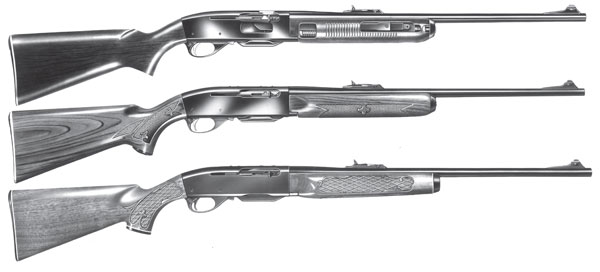
The 1990s began the era of niche marketing as distributors special ordered non-cataloged variations.. Black laminated or brown laminated stocks were offered in some years. Remington also produced a European market Model 7400 with a special two-shot magazine.
Several roll-engraved commemorative Model 742s and Model 7400s have been offered. 11,412 Model 742s with a goldfilled 150th Anniversary logo on the left side were sold in 1966. 1,968 Canadian Centennial Model 742, in caliber .308 Winchester, were sold in 1967. A number were offered as cased sets with a similarly appointed Ruger 10/22.
Remington celebrated the Bicentennial by offering 10,108 Model 742s with a gold-filled 1776 – 1976 logo on the left receiver panel. Fifteen hundred Limited Edition Model Fours, commemorating over 75 years of autoloader rifle production, were offered in 1982. Both side panels of the receiver were etched with scrollwork and the left panel featured a gold plated hunting scene based on a N. C. Wyeth painting from the Remington Arms Company Collection. The right panel featured gold plated Model 8 and the Model Four rifles. Approximately 5,000 of the 175th Anniversary rifles with an American Eagle and a scroll design roll marked on the left receiver panel were sold in 1991.
Page 22 4th Quarter 2009
Fewer than thirty five gun sets, consisting of a Model 700
bolt action Model 870 pump shotgun, Model 1100 autoloaded shotgun, Model 7400 autolader rifle and the Model 7600 rifle, were sold in 1996 to commemorate the 180th Anniversary or Remington. The Model 7400 left receiver panel had a pair of rams, a bust of Eliphalet Remington and a 180th Anniversary banner, all gold embellished. The right receiver panel had two gold embellished elk. The 1997 catalog offered the Buckmasters Limited Edition M7400 with special pressure applied fine-line engraving on both receiver panels and fewer than 800 were sold.
Remington President C.K. Davis (1933 to 1953) , L. Ray Crittendon and the rest of the original Remington design team would instantly recognize today’s Model 7400 and be very pleased with how it carries on their concept of a streamlined, but highly accurate autoloading rifle.
Page 23 4th Quarter 2009 On-line Search/Sort Journal Index
How can I submit an article for a future issue?
How can I purchase back issues of the RSA Journal?
On-line Journal Articles New Journals have links to
- From the editor
- Classifieds
- The Last word –











































